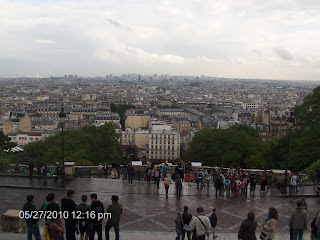
As I stood 300 meters, which is 984 ft. above ground, with the wind blowing against my face and my heart beating quickly from the long journey up the Eiffel Tower, I gazed in awe at the beautiful city of Paris. My group of friends and I were on the top of the the highest building in the center of Paris. The monument that I had always learned about in French class or seen on TV or in books; the monument that defined the city of Paris. As I admired the seemingly endless city I though to myself, if the Eiffel Tower was not here what would be the symboy of Paris? This monument has become automatically associated with Paris however I learned this weekend that has not always been the case.
When looking at a monument it is important to not only admire its beauty, architecture, and importance in the culture today, but also its history and how it came to be this worldy renowned monument. The Eiffel Tower indeed is one of the most magnificent monuments in the world. It was built for the 1889 Internation exposition, and named after its designer Gustave Eiffel. It was created to mark the 100th anniversary of the French Revolution. To my surprise, Parisians did not welcome the tower with open arms for many years. They felt it would change the image of Paris and put some other great monuments in the shadows. They also saw the enourmous height as ugly and a danger to the city. Although this is difficult to believe now since we associate French culture with the Eiffel Tower, at the time it was built and displayed many critics felt that the tower did not reflect their city’s culture in any way. This history of the Eiffel Tower is fascinating to me and unfortunately it seems to have been somewhat forgotten over the years as the tower stands the icon for Paris. This is the main Eiffel Tower Website and it will provide you with any additional information you would like from history to ticket prices. http://www.tour-eiffel.fr/teiffel/uk/

I looked all around, and made sure to take in as much as I could in the 15 minutes I had at the top. Who knows I may never have the oppurtunity to experience this again. So I began to think more. Why was it that the tower has become the symbol of Paris when the city is made up of so many other truly remarkable monuments? I believe it is because of many reasons. The Eiffel Tower is a public space in the center of Paris, which from up above makes everything else look as if it is surrounding and building outward from the tower. The extremely dense population of Paris was apparent from the top of the tower however I felt I was completely alone. Being so high up all I could hear was the wind and the distant sound of cars and buses honking down below. Even though I am not from France, I felt a sense of Parisan pride while standing on the top of the Tower. Earlier in the evening I watched as not only tourist but also locals have picnics on the lawns surrounding the Tower. These locals were demonstrating their nationalism for their homeland as they sat enjoying the beautiful sight. It was interesting to notice that there was hardly and green in Paris aside from the few areas around significant areas like the Eiffel Tower or the parks around the Louvre and Arc de Triomphe. This really signified which monuments the Parisians took great pride in.

My night at the Eiffel Tower is one that I will never forget! Learning about it when I was younger I never imagined myself actually standing at the top. The pictures are amazing to see however when you experience the real thing it takes your breath away. Not only was I able to get a sense of Paris nationalism and population but also French culture. We ate cheese and drank wine along with all of the locals. We even managed to meet a group of young peole from Paris who told us they come to this park every other Friday night because it is the best spot in Paris. It is amazing to see their passion for this monument. I was happy that some of their passion and excitement managed to wipe off on me. I will forever love the Eiffel Tower and the night I spent their learning about Paris is its culture.


























